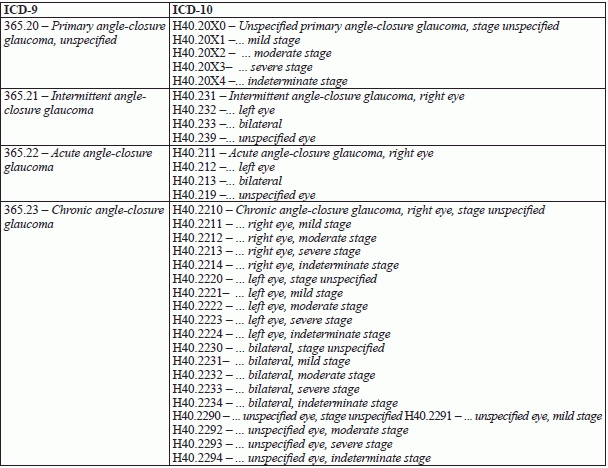Close In on New Dx Codes for Primary Angle-Closure Glaucoma
Hint: Know the significance of each character to identify most accurate code.
In ICD-10, eye codes have been expanded to increase anatomic specificity and add the concept of laterality. Many of the codes include right, left, bilateral and unspecified eye. If the option of “bilateral” is not available, and the condition is present in both eyes, it is correct to assign the code for right and left. However, if a code exists for bilateral, that should be assigned, not right and left eye.
The ICD-10 codes for primary angle-closure glaucoma (H40.2---) provide an example of how each character in an ICD-10 code gives specific information.
Characters 1-3: The first three characters identify the category of disease. In ICD-10, all of the glaucoma diagnosis codes begin with H40 (Glaucoma) or H42 (Glaucoma in diseases classified elsewhere). In general, all of the “Diseases of the eye and adnexa” series codes begin with characters H00-H59. Eye diseases share the first character “H” with “Diseases of the ear and mastoid process” (H60-H95), but some anatomical areas have a first character all to themselves (e.g., all “G” codes describe nervous system diseases, and all “I” codes are dedicated to the circulatory system).
Characters 4-7: In ICD-10, the fourth, fifth, and sixth characters identify the etiology, anatomic site, and/or severity of the disease. Don’t miss: Although the characters will have a standard meaning within each section, the meaning of each character may change between code series.
Within the glaucoma codes, the fourth character further describes the kind of glaucoma:
In the primary angle-closure glaucoma series (H40.2), the fifth character conveys information about the type of condition:
In the H40.22 series (Chronic angle-closure glaucoma …), the sixth character shows which eye the condition exists in:
Not all the glaucoma diagnosis codes have this level of specificity – some have an “X” for a sixth digit, as you’ll see in the table below. The “X” placeholder leaves room for further expansion of the code set.
Further along in the H40.22 series, the seventh character describes the stage of the disease:
Putting it all together: Mild-stage chronic angle-closure glaucoma in the right eye would be coded H40.2211. Moderate-stage chronic angle-closure glaucoma in the left eye would be coded H40.2222.
Read on for some specifics of how your diagnosis coding for closed-angle glaucoma will change once ICD-10 comes into effect on Oct. 1, 2015.
Stay tuned: Look for explanations of more of the closed-angle glaucoma codes in an upcoming issue of Ophthalmology Coding Alert.
Get ready: For more information on the ICD-10 conversion, as well as specific ICD-9 to ICD-10 code bridges, visit https://www.aapc.com/codes/.


